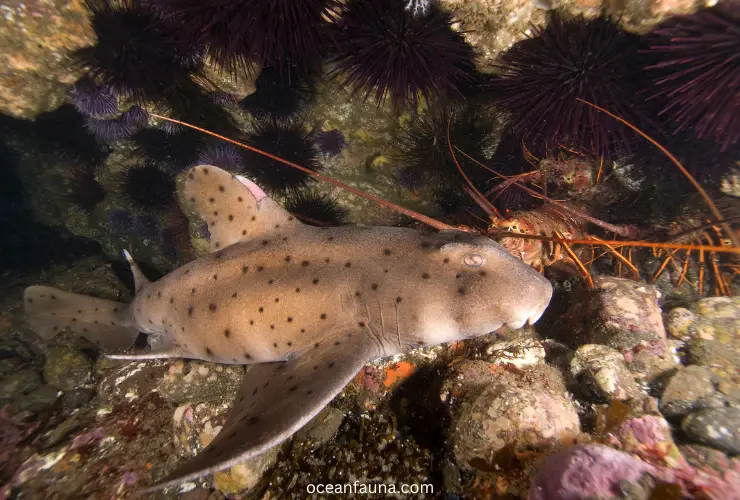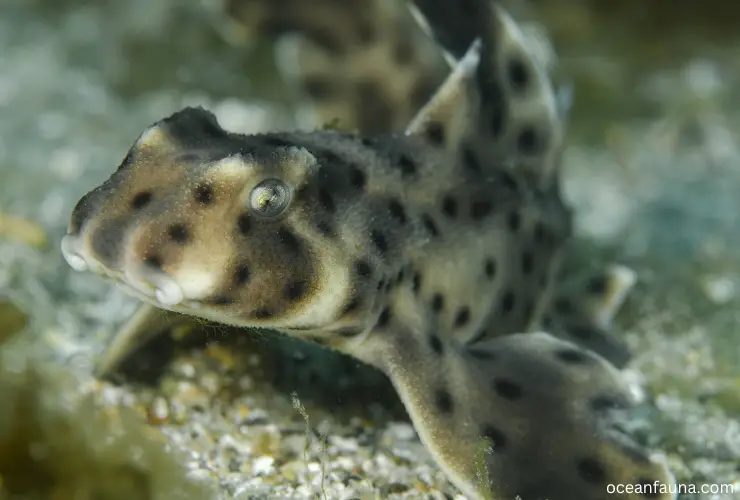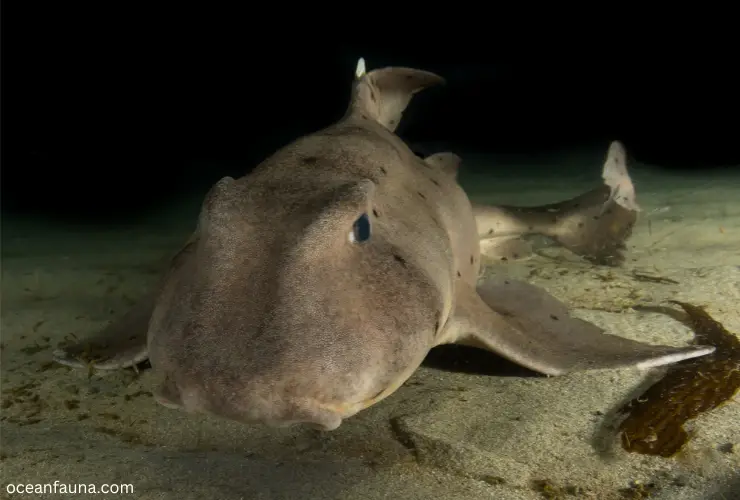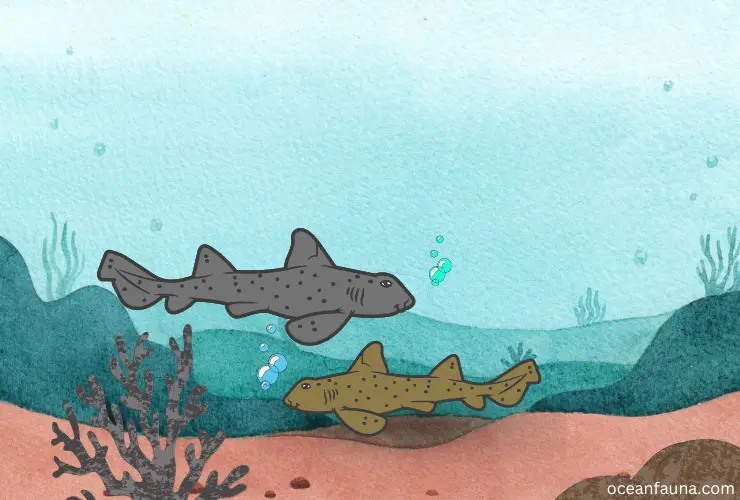From the name, you might understand the Horn shark is one of the venomous sharks, mainly the Port Jackson species. Horn Sharks have adapted to the inviting waters of tropical and warm-temperate zones in the Eastern Pacific Ocean.
With this incredible shark, there are countless questions that people have. In this detailed article, I will try to address everything so that you have a compact knowledge of the horn shark.

About: Horn Shark
| Category | Information |
| Common Names | Horn shark |
| Scientific Name | Heterodontus francisci |
| Order | Heterodontiformes |
| Family | Heterodontidae |
| Diet | Crustaceans, mollusks, small fish, and sea urchins |
| Habitat | Rocky and sandy bottoms, kelp forests, and reefs |
| Distribution | Eastern Pacific from southern Oregon to central Mexico |
| Size | 3 to 4 feet (0.9 to 1.2 meters) in length |
| Weight | 20-23 lb (9-10.4 kg) |
| Life Expectancy | Up to 25 years |
| Reproduction | Oviparous (lays eggs) |
| Litter Size | 12 to 24 eggs |
| Conservation Status | Data Deficient |
The horn shark is a unique species that belongs to the bullhead shark family. It is found only in the coastal waters along the western coast of North America, from California to the Gulf of California.
The horn shark is small-sized, typically growing up to 3-4 feet in length. It has a stout body covered with small, rough scales, which provide excellent protection against predators. The shark’s coloration is a mix of brown, gray, and black, with darker spots covering its body.
One of the most interesting facts about the horn shark is its teeth. Unlike most sharks, which have single rows of teeth that eventually fall out and are replaced by new ones, the horn shark has two types of teeth in its jaws.
The front teeth are sharp and pointed, designed for grabbing and holding prey, while the back teeth are flattened and used for crushing hard-shelled prey like crustaceans and mollusks.
The horn shark is a nocturnal species, spending its days hiding in rocky crevices and caves along the ocean floor. They emerge to feed on small fish, crabs, and other invertebrates at night.
Despite its medium size, the horn shark poses no threat to humans, as it is not aggressive and rarely comes into contact with people. In fact, it is one of the most popular species of sharks kept in aquariums due to its unique appearance and peaceful nature.
Fun Facts: Horn Sharks
- Horn sharks are from bullhead sharks, not bull sharks.
- The Horn shark has derived its name from the horn-like protrusion in front of its dorsal fin.
- Port Jackson is a venomous horn shark species.
- The horn shark is a nocturnal species that mainly feed at night.
- These sharks can live ranging from 25-50 years in the wild.
- The conservation status of horn sharks is ” Data Deficient.”
Do Horn Sharks Have Real Venomous Horns?
Most of the horn sharks, such as the Port Jackson species, do, in fact, have horns that contain venom. While not all species of horn sharks are venomous, those that are can deliver a painful bite if provoked.
The venom in their horns is primarily used for defense against predators and can cause symptoms such as swelling, pain, and even paralysis in some cases. It is important to handle horn sharks with caution and to avoid provoking them whenever possible.
Additionally, horn sharks are not typically aggressive toward humans and are more likely to flee from potential threats than to attack.

Anatomy of Horn Shark
The horn shark is mainly found in the eastern Pacific Ocean and has a unique anatomical structure that makes it stand out from other shark species. Below are the different anatomical systems of the horn shark explained in detail.
Appearance
The horn shark’s magnificent exterior is dappled with grayish-brown to black pigments, decorated by an arrangement of dark spots. Its renowned name derives from its two prominent spines that are located before the first dorsal fin – sometimes even found in front of each one.
Skeletal System
The horn shark has a unique skeletal structure that comprises its teeth and skull. Their skull is strong and wide, with a short snout with sharp, well-formed teeth. These teeth, such as crustaceans and small fish, are used for crushing their prey. The rest of the body has a cartilaginous structure that gives it flexibility and makes it easier for the shark to maneuver in the water.
Nervous System
Like all vertebrates, the horn shark has a centralized nervous system that comprises the brain, spinal cord, and nerves. The shark’s sensory system is excellent, with eight cranial nerves utilized to sense stimuli.
These nerves allow them to sense sensations like smell, touch, taste, and sound. This sensory ability helps the shark in locating its prey and evading predators.
Cardiovascular System
The horn shark has a single, large heart that pumps blood throughout its body. Their heart has two chambers, and pumps deoxygenated blood to the gills and then pumps oxygenated blood to the rest of the body. The blood also helps to regulate the shark’s body temperature, keeping it at an optimal range for its body.
Respiratory System
The horn shark’s respiratory system comprises a pair of gills on the sides of the head. These gills extract oxygen from the water and remove carbon dioxide, allowing the shark to breathe underwater. The shark must continuously swim to keep water moving over its gills to allow for proper oxygenation.
Digestive System
The horn shark’s digestive system is unique in that it has two stomachs. The first stomach is used for the storage of food, and the second stomach is used for the digestion of food. The shark has a strong jaw that helps in breaking up hard prey, and its teeth also work to shred and grind the food before being swallowed.
How Big Is a Horn Shark?
The Horn Shark is a medium-sized species that can grow to a total length of 3-4 feet or 36-48 inches (91-122 cm). The body width of these sharks typically ranges from 6.7-9 inches (17-23 cm).
The males of this species reach sexual maturity at a length of 22-24 inches (56-61 cm), while the females mature at a length of at least 23 inches (58 cm).
On average, a fully grown Horn Shark weighs around 20-23 pounds (9-10.4 kg). These sharks have a robust and bulky body structure, which contributes to their impressive size and weight.
Where Do Horn Sharks Live?
The horn shark, scientifically known as Heterodontus francisci, is mainly found in warm-temperate and subtropical waters of the eastern Pacific Ocean. Its distribution ranges from central California to the Gulf of California.
These sharks prefer to inhabit continental shelves and can be found at depths of up to 152 meters (499 feet), although they are typically seen swimming at depths of 2-11 meters (7-36 feet). They thrive in waters with temperatures around 20°C (70°F).
Horn sharks have a unique migration pattern; during winter, they move to deeper waters beyond 30 meters (98 feet).
They are nocturnal animals that are relatively small in size, usually growing up to a maximum length of 120 centimeters (47 inches). Their skin color ranges from dark brown to grey, with a spiky appearance that helps them camouflage themselves on rocky seabeds.
The horn shark is mainly found in the eastern Pacific Ocean, but there have been reports of their sightings in other parts of the world, including the western coast of the United States and Chile.
They are also known to inhabit areas close to kelp forests, where they take refuge during the day. These sharks are mostly solitary animals and do not travel in schools, although they have been documented forming groups during the breeding season.
Also, these sharks can be kept in big aquariums (containing 500 gallons of water) with other fishes like damselfish, triggerfish, and angel fish. Special attention must be taken to provide the horn shark with enough hiding places in these tanks.

What Do Horn Sharks Eat?
Horn sharks primarily feed on seafloor invertebrates, with sea urchins and crabs being their favorite food. They also occasionally eat small fish. Horn sharks hunt for their prey in the wild using their strong jaws and sharp teeth. They often hide in caves and crevices during the day and come out at night to hunt.
In aquarium settings, horn sharks can be fed a diet of squid, shrimp, and pieces of fish. Ensure that they are getting a varied diet to meet their nutritional needs.
In the wild, horn sharks have a high demand for calcium, which they get from eating prey with hard exoskeletons like sea urchins. In captivity, calcium supplementation may be required to keep them healthy.
Their hunting strategy involves stalking their prey and then attacking quickly with their powerful jaws. They are not very fast swimmers but are efficient hunters due to their excellent sense of smell and electroreception abilities.
Their small size and ability to hide in small spaces make them well-suited for hunting in rocky reef environments.
What Is the Lifespan Of Horn Sharks?
Horn sharks are known for their impressively long lifespan, with the ability to live up to 25 years in the wild. However, some individuals have been recorded to live up to 50 years old. These sharks spend their entire lives in the same location and are known to be highly territorial, which may contribute to their longevity.
Factors such as diet, genetics, and environmental conditions all play a role in determining the lifespan of horn sharks. Their slow growth and low reproductive rates may also contribute to their extended lifespan.
Moreover, some researchers speculate that the longevity of horn sharks may also be linked to their low metabolic rate. Unlike many other shark species, horn sharks have a relatively low activity level, which may require less energy and allow them to conserve resources throughout their lives.
How Do Horn Sharks Reproduce?
Horn sharks reproduce through an oviparous process, which means that the females lay eggs rather than give birth to live young. During a single breeding season, females can lay up to 24 eggs, usually between February and April. The eggs are deposited every 11-14 days, with each clutch containing two eggs.
After the eggs are laid, the embryos develop for about 6 to 10 months, depending on the water temperature. Once fully developed, the baby horn sharks measure 6 to 7 inches long.
Interestingly, at birth, the babies’ spines are sharp, which protects them from being eaten by predators such as angel sharks or sea bass.
Horn sharks have a complex reproductive system, with males having paired reproductive organs known as claspers. Mating occurs when the male inserts one of his claspers into the female’s cloaca, where fertilization occurs. Male horn sharks will sometimes bite and hold onto the female’s pectoral fins during mating.
Overall, horn sharks have a unique and fascinating reproductive system that allows for successful reproduction and survival of the species. Understanding the nuances of horn shark reproduction is essential to conserving and protecting these incredible creatures in the wild.
Are Horn Sharks Aggressive to Humans?
Horn sharks are generally not considered aggressive toward humans. They are a smaller species of shark, typically growing to around 3-4 feet in length, and are known for having a distinctive horn-like protrusion just before the dorsal fin. In fact, under normal circumstances, horn sharks are quite docile and can even be approached underwater without issue.
However, horn sharks, like any wild animal, can be provoked into biting if they feel threatened or harassed. In some rare instances, pugnacious individuals have been known to chase and bite divers who have provoked them.
So, treat these creatures with respect in their natural habitat and avoid any actions that could endanger both the shark and humans.
It is worth noting that there is only one recorded instance of a Heterodontid shark, specifically a Port Jackson shark, biting a human. While this occurred in Australia, it does not indicate the behavior of horn sharks.
In general, horn sharks are considered to be harmless to humans and can coexist safely in their natural habitats.

What Is the Conservation Status of Horn Sharks?
Not enough information is available to accurately determine horn sharks’ population and overall health status. So, the conservation status of horn sharks is currently listed as Data Deficient by the International Union for Conservation of Nature (IUCN).
One of the main reasons for this lack of data is the fact that commercial fisheries do not commonly target horn sharks, and they are not frequently captured or monitored by researchers. Their secretive nature and preference for deeper waters make them difficult to study.
However, there are some concerns about the potential impact of human activities on horn shark populations. Like many other shark species, horn sharks are vulnerable to habitat degradation and pollution, which can disrupt their feeding and breeding behaviors.
They are also sometimes caught as bycatch in fishing gear intended for other species, which can result in injury or death.
Further research and monitoring efforts are needed to gain a better understanding of horn shark populations and the threats they face. This information can help inform conservation strategies to protect and preserve these unique and important sharks for future generations.
Conclusion
Now you have a compact knowledge of horn sharks. If you have any further queries about this shark, just keep your question in the comment box below.


3 thoughts on “Horn Shark: Facts of a Shark With Venomous Horn”